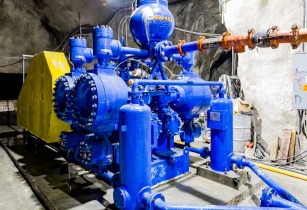The technical advancement of Weir Minerals’ GEHO positive displacement pumps has ensured they play a key role in reducing mines’ environmental footprint
The GEHO pump range is well known in various pumping applications including tailings, backfill, ore transportation and dewatering. Weir Minerals global product manager for GEHO positive displacement (PD) pumps, Erik Vlot, highlights the pumps’ ability to pump highly viscous slurry, allowing mines to conserve water. The energy efficiency of pipeline transportation also helps cut energy costs and reduces mines’ carbon footprint.
“The foundation of GEHO pumps’ success is our ongoing attention to technical innovation and improvement,” says Vlot. “This also allowed us to be pioneers in the pumping of very acidic material at high temperatures, such as nickel slurry at more than 200°C at a mine in Madagascar."
With their high capacity, GEHO pumps transport bauxite or iron ore over hundreds of kilometres, offering one of the most cost effective and sustainable transfer methods available to the mining industry. These pumps have also played an integral role in the success of a Weir Minerals paste solution at Finland’s largest open pit mine. Yara’s Siilinjärvi mine uses GEHO pumps to move tailings from the plant, achieving the necessary beach slope on its tailings facility to meet its life-of-mine strategy.
Backfilling is an important method for mining to achieve safety and environmental goals, and GEHO pumps have been enabling this work. In a North American platinum operation, the equipment pumps over a thousand litres a minute of this viscous backfill material – measuring 70% solids by weight – back into the mine’s worked out areas.
In the context of deep mines, GEHO pumps provide an efficient and reliable way of dewatering from great depths, instead of using multiple smaller pumps to transfer water to surface. The powerful range can do this by pumping from the bottom of a mine to the surface in just one lift – even over kilometres.
“Apart from the cost effectiveness of this solution, an important advantage is that it reduces the risk of one pump in a pumping chain failing, and disrupting the entire dewatering function,” he says. “It also reduces the cost and maintenance requirements of having multiple pumping stations at different levels within the mine.”
The reputation of GEHO pumps has also been built on their reliability, he explains. This has resulted from Weir Minerals’ ongoing research and development into its pumps’ wear parts. This process is based on an in-depth understanding of the whole pumping system in which the pump operates.
“Taking into account how our pumps interact with these systems, we focus on key aspects of the pumps such as the diaphragm and propelling liquid system,” he says. The propelling liquid provides the barrier between the piston and the diaphragm ensuring that all the moving parts move in oil and not slurry.
He emphasises the importance of diaphragm dynamics and the need to control the volume of propelling liquid in the chamber. This is done through the PLC control, to ensure that the diaphragm runs in the right position.
“Rubber is good at bending, but if it stretches it can tear,” he says. “Our aim is to extend the replacement intervals between diaphragm replacements, helping mines to reduce both their downtime and their total cost of ownership.”
The monitoring of GEHO pumps’ operation is conducted through digital technology so that operators can stay abreast – in real time – of the pump’s performance and condition. Weir Minerals’ digital layer for these pumps is being rolled out to customers, informing the maintenance schedules and enhancing pump availability.





















